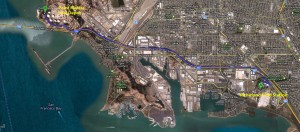
In a statement released this morning, the University of California, Berkeley announced it has chosen the Richmond Field Station to locate its second new laboratory. The site, already owned by the university, would be best suited to handle "long-term growth" and "pressing space problems," the statement read.
KQED's Quest Reporter Amy Standen covered the story last week, taking a look at the six locations that had been narrowed down as possible choices. Sites in Alameda, Albany, Berkeley, Emeryville, Oakland and Richmond were considered.
Six Bay Area Cities Play the Waiting Game
Will Travis – who, until recently, headed the Bay Conservation and Development Commission, a state agency that regulates building around the bay – says, sure, big development projects happen all the time in the Bay Area. But Lawrence Berkeley labs is what he calls "a platinum level, marquee" project.
Since it was founded in 1931, thirteen Nobel prizes have been won on work done here. Sixteen elements added to the periodic table. World-famous innovations in medical science, alternative energy and atomic research that helped win World War II.
"It reflects who we are as a society, a knowledge-based society," says Travis, "and this is the epitome of that."
With a staff of 4,000 and a budget of more than $800 million, the Lawrence Berkeley Lab has been overflowing its headquarters in the Berkeley Hills for some time. Research on biofuels and other fields has spilled over to satellite offices in Emeryville and Walnut Creek. The idea is to consolidate those operations into a second campus.
All of the sites were "flat and near the water," Standen reported, and several had unique features. The Alameda site was the decommissioned Naval Base; the Albany site was near bird habitats and could ruffle feathers among avid bird watchers.
Three of the sites were partially located in Berkeley; our news partner Berkeleyside covers the story from that city's angle. KQED Staff covered the multi-city showdown as it unfolded last summer.
